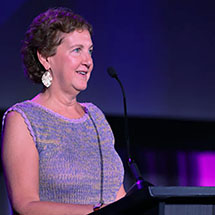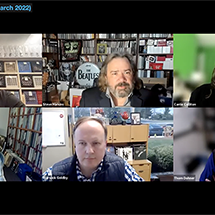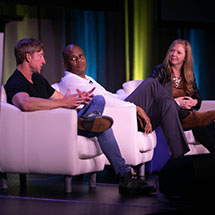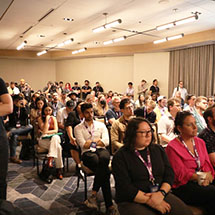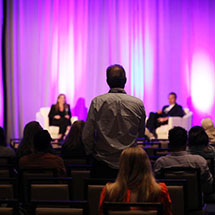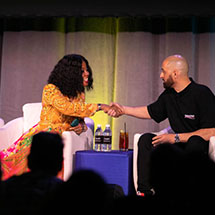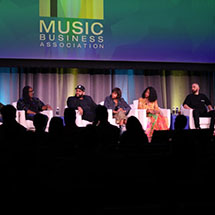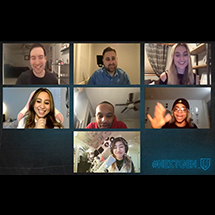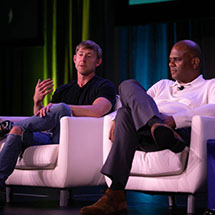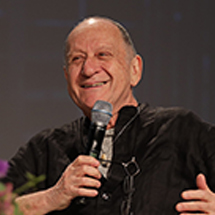
[Keeping Tempo With Music Biz] — The Ever-Evolving Business of Music Lyrics: Interview with LyricFind’s Darryl Ballantyne

The monetization of song lyrics has opened an important revenue stream for modern artists and our industry as a whole. Artists now have more ways to leverage their lyrics so fans can more easily discover, understand and relate to their works, thanks to companies like LyricFind who developed tech to facilitate these interactions. On the occasion of LyricFind’s 20th anniversary, we sat down with the company’s Founder & CEO, Darryl Ballantyne to discuss LyricFind’s origins and path to success, how it has innovated alongside an industry that’s radically different than it was in 2004, and what lyric product offerings might look like in the future!
Music Biz: Congratulations to the LyricFind team as you celebrate your 20th anniversary this year! Can you talk about what inspired you to pursue this path for the company — was it born from a personal passion, after identifying a need in the marketplace, or maybe both?
Darryl Ballantyne: A bit of both, really — I was always a huge music fan and despite having no musical talent of my own, I was always the “name that tune” guy growing up. One of my co-founders, Chris Book, was trying to figure out the name of a song based on the lyrics, and for once, I didn’t know the answer. When he tried searching online, he saw the market gap, and the rest is history.
Music Biz: Was there a moment or moments along your journey that you knew with certainty that you were onto something important by offering access to high-quality lyrics on behalf of artists & rightsholders?
DB: There were many such moments along the way that kept us going. EMI believing in us to sign the first-ever mass lyrics licensing deal. HFA (and specifically Lauren Apolito!) doing the same, and for basically nothing because they knew we didn’t have any funding but believed in the business we were building. The first deal we did with Rhapsody, who were the first streaming service to embrace lyrics. And of course, hearing over and over again from writers and publishers that it mattered — that fans had told them about connecting with their songs by following the lyrics online, or that they saw the LyricFind line item on their statement and it was meaningful.
Music Biz: To mark your two-decade milestone, LyricFind announced the addition of the 10 millionth song to its licensed lyrics database earlier this year. Tell us about what this “diamond” achievement means to you & the company, as well as in the context of music lyric operations as a whole.
DB: Realistically, it tells us that we still have a long way to go, and it’s hard to keep up! There’s so much music being released now, we’re still only scratching the surface. It’s taken us 20 years to get to 10 million; how fast can we get to 100 million, or more? We’re actually already up close to 12 million since we made that announcement, so we’re moving really fast — but it’s hard to maintain quality when adding quantity, so that’s a constant challenge for us and the industry in general. We’ve got an incredible content team, though, and if anyone can do it, it’s them!
Music Biz: Our industry is one that evolves at a rapid pace — are there particular innovations and trends that emerged in your first two decades that proved to be watershed moments in LyricFind’s story?
DB: A lot has certainly happened in 20 years! The big, obvious one is streaming — it’s the main driver of the industry and didn’t exist when we got started; neither did the iPhone! Between streaming and smartphones, they’ve completely transformed the music industry. Beyond that, though, there have been less anticipated innovations — if you’d told me 10 years ago that we would’ve been putting lyrics in cars, I would’ve thought you were crazy — but we are! The growth of video has been a huge factor as well; there was no YouTube when we started, either!
Music Biz: Lyrics were previously only accessible to fans in liner notes with vinyl records and CDs they purchased. Nowadays official lyrics are built into modern DSPs, and are deemed important enough to share with all users that previous paywalls to access lyrics have been removed. As the ways that fans access song lyrics have changed, how did LyricFind need to evolve and meet the needs of digital music consumption?
DB: Lyrics integrations have changed a lot over the years. At first, we just had static lyrics on web sites. As DSPs evolved, though, lyrics moved to mobile applications, and became synchronized — first on a line-by-line basis, then later, word-by-word. More recently, we’ve added translations, enabling greater understanding of music across languages and cultures. All through the years, though, one thing has consistently grown: fans’ insatiable desire for lyrics, and a better understanding of their favorite music!
Music Biz: LyricFind’s LyricIQ product provides important contextual data to songs and groups them based on similar emotions & sentiment, delivers subject matter info to group songs on themes & topics mentioned, and offers content analysis for filtering purposes. Since its debut, how has this tool been leveraged by different industry stakeholders?
DB: LyricIQ is one of our most fascinating products, in my opinion. It opens up a whole new world of discovering and understanding music that wasn’t available before, and makes music truly searchable by content, rather than just genre or musical attributes. It’s currently used by various partners for recommendations, playlisting, content filtration and more, often behind the scenes. As a parent myself, my favorite application is using the Content Filters to create a family-friendly listening environment — there’s so much music being released now, no parent can possibly keep up with what’s appropriate!
Music Biz: Today’s increasingly borderless world means that music fans can access songs from around the world in an instant. Lyric translation services greatly benefit those who want a deeper understanding of songs written in languages foreign to them. When did you see this part of your business start to take off, and do you see it as a potential way for artists to connect with new worldwide audiences?
DB: The potential has always seemed obvious — at least ever since I met Robert Singerman, who’s now worked with us for over a decade (and it was obvious to him long before that). But translations are finally starting to have their moment in the sun, and it started two years ago when Deezer became the first DSP to launch translations, powered by LyricFind. Now, more and more DSPs have followed their lead, with more to come. As a result, translations are becoming more of a core part of the lyrics experience, as Robert always predicted they would.
Music Biz: Lyric videos have been a powerful promotional tool for artists since the early days of YouTube. You recently acquired Rotor Videos to expand your company’s video-centric offerings — can you tell us about how you’ve adapted to offer new lyric video products as music platforms have become more dynamic and interactive?
DB: Lyric Videos were a logical extension of our service that was nicely pointed out to us by Bill Wilson (then at MNRK): we had lyrics, and synchronization data, so wouldn’t it be simple to automatically create lyric videos? It was a no-brainer moment. Music has become an increasingly visual medium, with video everywhere, so it made sense to capture some of that market. Since then, we’ve been generating thousands of lyric videos (for MNRK and others) at a super low cost for artists and labels to capture an important piece of content and monetization. The acquisition of Rotor was a logical extension of this. Not only did they also do lyric videos, but they’d also build out the whole front end infrastructure we needed, plus many other video formats like Spotify Canvas, Apple Album Motion Art, Art Videos, and more — they’ve been a great addition to the team.
Music Biz: LyricFind also has a broad slate of offerings for music fans, including its fan-reported lyrics tool, a searchable lyric database for your catalog, Billboard charts for the most popular lyrics in the U.S. and globally, and more. Given the company’s robust enterprise options, why has it been important to develop & maintain the fan-focused tools?
DB: In short, because it’s impossible to keep up with all the music being released now. Having the fan-focused side allows fans to help contribute to the database (their contributions are still vetted by our content team to ensure quality), which makes us more efficient. It also keeps us honest; we aren’t 100% perfect, so we’re happy to get the occasional corrections when we’ve missed something. It’s also really helpful on the international side, for languages we don’t have full-fledged teams for. The Billboard Charts are another of my favorite things — they were the brainchild of Will Mills, who was our Chief Revenue Officer for years, and they really give a different perspective on trending music outside of just the regular Hot 100.
Music Biz: What trends or tech do you see making a splash in our industry, both in and out of the music lyrics space, in the near and far future?
DB: Automotive is a key area that’s really going to take off more and more. Once autonomous driving becomes more prevalent, the car becomes the ideal entertainment center — and music will be a huge part of that! We’re also going to see big increases in content production (yes, even more so than we already have!) through AI and automation, whether that’s for video creation (for all different platforms), or lyric transcription, sync, and translation (with human verification, at least for a while yet). I’m also hopeful we’ll see further price increases for streaming services, which should give them more margin to play with to add new features to the package — and come up with cool things we aren’t even thinking about yet!
You can read past “Keeping Tempo” articles via the portal linked here. And, stay tuned for more insightful discussions from our members and partners from across the industry!

